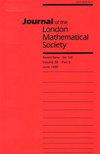子空间包含图的拉普拉奇特征值的渐近行为
IF 1
2区 数学
Q1 MATHEMATICS
Journal of the London Mathematical Society-Second Series
Pub Date : 2024-08-13
DOI:10.1112/jlms.12972
Alan Lew
{"title":"子空间包含图的拉普拉奇特征值的渐近行为","authors":"Alan Lew","doi":"10.1112/jlms.12972","DOIUrl":null,"url":null,"abstract":"<p>Let <span></span><math>\n <semantics>\n <msub>\n <mtext>Fl</mtext>\n <mrow>\n <mi>n</mi>\n <mo>,</mo>\n <mi>q</mi>\n </mrow>\n </msub>\n <annotation>$\\text{Fl}_{n,q}$</annotation>\n </semantics></math> be the simplicial complex whose vertices are the nontrivial subspaces of <span></span><math>\n <semantics>\n <msubsup>\n <mi>F</mi>\n <mi>q</mi>\n <mi>n</mi>\n </msubsup>\n <annotation>$\\mathbb {F}_q^n$</annotation>\n </semantics></math> and whose simplices correspond to families of subspaces forming a flag. Let <span></span><math>\n <semantics>\n <mrow>\n <msubsup>\n <mi>Δ</mi>\n <mi>k</mi>\n <mo>+</mo>\n </msubsup>\n <mrow>\n <mo>(</mo>\n <msub>\n <mtext>Fl</mtext>\n <mrow>\n <mi>n</mi>\n <mo>,</mo>\n <mi>q</mi>\n </mrow>\n </msub>\n <mo>)</mo>\n </mrow>\n </mrow>\n <annotation>$\\Delta ^{+}_k(\\text{Fl}_{n,q})$</annotation>\n </semantics></math> be the <span></span><math>\n <semantics>\n <mi>k</mi>\n <annotation>$k$</annotation>\n </semantics></math>-dimensional weighted upper Laplacian on <span></span><math>\n <semantics>\n <msub>\n <mtext>Fl</mtext>\n <mrow>\n <mi>n</mi>\n <mo>,</mo>\n <mi>q</mi>\n </mrow>\n </msub>\n <annotation>$ \\text{Fl}_{n,q}$</annotation>\n </semantics></math>. The spectrum of <span></span><math>\n <semantics>\n <mrow>\n <msubsup>\n <mi>Δ</mi>\n <mi>k</mi>\n <mo>+</mo>\n </msubsup>\n <mrow>\n <mo>(</mo>\n <msub>\n <mtext>Fl</mtext>\n <mrow>\n <mi>n</mi>\n <mo>,</mo>\n <mi>q</mi>\n </mrow>\n </msub>\n <mo>)</mo>\n </mrow>\n </mrow>\n <annotation>$\\Delta ^{+}_k(\\text{Fl}_{n,q})$</annotation>\n </semantics></math> was first studied by Garland, who obtained a lower bound on its nonzero eigenvalues. Here, we focus on the <span></span><math>\n <semantics>\n <mrow>\n <mi>k</mi>\n <mo>=</mo>\n <mn>0</mn>\n </mrow>\n <annotation>$k=0$</annotation>\n </semantics></math> case. We determine the asymptotic behavior of the eigenvalues of <span></span><math>\n <semantics>\n <mrow>\n <msubsup>\n <mi>Δ</mi>\n <mn>0</mn>\n <mo>+</mo>\n </msubsup>\n <mrow>\n <mo>(</mo>\n <msub>\n <mtext>Fl</mtext>\n <mrow>\n <mi>n</mi>\n <mo>,</mo>\n <mi>q</mi>\n </mrow>\n </msub>\n <mo>)</mo>\n </mrow>\n </mrow>\n <annotation>$\\Delta _{0}^{+}(\\text{Fl}_{n,q})$</annotation>\n </semantics></math> as <span></span><math>\n <semantics>\n <mi>q</mi>\n <annotation>$q$</annotation>\n </semantics></math> tends to infinity. In particular, we show that for large enough <span></span><math>\n <semantics>\n <mi>q</mi>\n <annotation>$q$</annotation>\n </semantics></math>, <span></span><math>\n <semantics>\n <mrow>\n <msubsup>\n <mi>Δ</mi>\n <mn>0</mn>\n <mo>+</mo>\n </msubsup>\n <mrow>\n <mo>(</mo>\n <msub>\n <mtext>Fl</mtext>\n <mrow>\n <mi>n</mi>\n <mo>,</mo>\n <mi>q</mi>\n </mrow>\n </msub>\n <mo>)</mo>\n </mrow>\n </mrow>\n <annotation>$\\Delta _{0}^{+}(\\text{Fl}_{n,q})$</annotation>\n </semantics></math> has exactly <span></span><math>\n <semantics>\n <mrow>\n <mfenced>\n <msup>\n <mi>n</mi>\n <mn>2</mn>\n </msup>\n <mo>/</mo>\n <mn>4</mn>\n </mfenced>\n <mo>+</mo>\n <mn>2</mn>\n </mrow>\n <annotation>$\\left\\lfloor n^2/4\\right\\rfloor +2$</annotation>\n </semantics></math> distinct eigenvalues, and that every eigenvalue <span></span><math>\n <semantics>\n <mrow>\n <mi>λ</mi>\n <mo>≠</mo>\n <mn>0</mn>\n <mo>,</mo>\n <mi>n</mi>\n <mo>−</mo>\n <mn>1</mn>\n </mrow>\n <annotation>$\\lambda \\ne 0,n-1$</annotation>\n </semantics></math> of <span></span><math>\n <semantics>\n <mrow>\n <msubsup>\n <mi>Δ</mi>\n <mn>0</mn>\n <mo>+</mo>\n </msubsup>\n <mrow>\n <mo>(</mo>\n <msub>\n <mtext>Fl</mtext>\n <mrow>\n <mi>n</mi>\n <mo>,</mo>\n <mi>q</mi>\n </mrow>\n </msub>\n <mo>)</mo>\n </mrow>\n </mrow>\n <annotation>$\\Delta _{0}^{+}(\\text{Fl}_{n,q})$</annotation>\n </semantics></math> tends to <span></span><math>\n <semantics>\n <mrow>\n <mi>n</mi>\n <mo>−</mo>\n <mn>2</mn>\n </mrow>\n <annotation>$n-2$</annotation>\n </semantics></math> as <span></span><math>\n <semantics>\n <mi>q</mi>\n <annotation>$q$</annotation>\n </semantics></math> goes to infinity. This solves the zero-dimensional case of a conjecture of Papikian.</p>","PeriodicalId":49989,"journal":{"name":"Journal of the London Mathematical Society-Second Series","volume":"110 3","pages":""},"PeriodicalIF":1.0000,"publicationDate":"2024-08-13","publicationTypes":"Journal Article","fieldsOfStudy":null,"isOpenAccess":false,"openAccessPdf":"https://onlinelibrary.wiley.com/doi/epdf/10.1112/jlms.12972","citationCount":"0","resultStr":"{\"title\":\"Asymptotic behavior of Laplacian eigenvalues of subspace inclusion graphs\",\"authors\":\"Alan Lew\",\"doi\":\"10.1112/jlms.12972\",\"DOIUrl\":null,\"url\":null,\"abstract\":\"<p>Let <span></span><math>\\n <semantics>\\n <msub>\\n <mtext>Fl</mtext>\\n <mrow>\\n <mi>n</mi>\\n <mo>,</mo>\\n <mi>q</mi>\\n </mrow>\\n </msub>\\n <annotation>$\\\\text{Fl}_{n,q}$</annotation>\\n </semantics></math> be the simplicial complex whose vertices are the nontrivial subspaces of <span></span><math>\\n <semantics>\\n <msubsup>\\n <mi>F</mi>\\n <mi>q</mi>\\n <mi>n</mi>\\n </msubsup>\\n <annotation>$\\\\mathbb {F}_q^n$</annotation>\\n </semantics></math> and whose simplices correspond to families of subspaces forming a flag. Let <span></span><math>\\n <semantics>\\n <mrow>\\n <msubsup>\\n <mi>Δ</mi>\\n <mi>k</mi>\\n <mo>+</mo>\\n </msubsup>\\n <mrow>\\n <mo>(</mo>\\n <msub>\\n <mtext>Fl</mtext>\\n <mrow>\\n <mi>n</mi>\\n <mo>,</mo>\\n <mi>q</mi>\\n </mrow>\\n </msub>\\n <mo>)</mo>\\n </mrow>\\n </mrow>\\n <annotation>$\\\\Delta ^{+}_k(\\\\text{Fl}_{n,q})$</annotation>\\n </semantics></math> be the <span></span><math>\\n <semantics>\\n <mi>k</mi>\\n <annotation>$k$</annotation>\\n </semantics></math>-dimensional weighted upper Laplacian on <span></span><math>\\n <semantics>\\n <msub>\\n <mtext>Fl</mtext>\\n <mrow>\\n <mi>n</mi>\\n <mo>,</mo>\\n <mi>q</mi>\\n </mrow>\\n </msub>\\n <annotation>$ \\\\text{Fl}_{n,q}$</annotation>\\n </semantics></math>. The spectrum of <span></span><math>\\n <semantics>\\n <mrow>\\n <msubsup>\\n <mi>Δ</mi>\\n <mi>k</mi>\\n <mo>+</mo>\\n </msubsup>\\n <mrow>\\n <mo>(</mo>\\n <msub>\\n <mtext>Fl</mtext>\\n <mrow>\\n <mi>n</mi>\\n <mo>,</mo>\\n <mi>q</mi>\\n </mrow>\\n </msub>\\n <mo>)</mo>\\n </mrow>\\n </mrow>\\n <annotation>$\\\\Delta ^{+}_k(\\\\text{Fl}_{n,q})$</annotation>\\n </semantics></math> was first studied by Garland, who obtained a lower bound on its nonzero eigenvalues. Here, we focus on the <span></span><math>\\n <semantics>\\n <mrow>\\n <mi>k</mi>\\n <mo>=</mo>\\n <mn>0</mn>\\n </mrow>\\n <annotation>$k=0$</annotation>\\n </semantics></math> case. We determine the asymptotic behavior of the eigenvalues of <span></span><math>\\n <semantics>\\n <mrow>\\n <msubsup>\\n <mi>Δ</mi>\\n <mn>0</mn>\\n <mo>+</mo>\\n </msubsup>\\n <mrow>\\n <mo>(</mo>\\n <msub>\\n <mtext>Fl</mtext>\\n <mrow>\\n <mi>n</mi>\\n <mo>,</mo>\\n <mi>q</mi>\\n </mrow>\\n </msub>\\n <mo>)</mo>\\n </mrow>\\n </mrow>\\n <annotation>$\\\\Delta _{0}^{+}(\\\\text{Fl}_{n,q})$</annotation>\\n </semantics></math> as <span></span><math>\\n <semantics>\\n <mi>q</mi>\\n <annotation>$q$</annotation>\\n </semantics></math> tends to infinity. In particular, we show that for large enough <span></span><math>\\n <semantics>\\n <mi>q</mi>\\n <annotation>$q$</annotation>\\n </semantics></math>, <span></span><math>\\n <semantics>\\n <mrow>\\n <msubsup>\\n <mi>Δ</mi>\\n <mn>0</mn>\\n <mo>+</mo>\\n </msubsup>\\n <mrow>\\n <mo>(</mo>\\n <msub>\\n <mtext>Fl</mtext>\\n <mrow>\\n <mi>n</mi>\\n <mo>,</mo>\\n <mi>q</mi>\\n </mrow>\\n </msub>\\n <mo>)</mo>\\n </mrow>\\n </mrow>\\n <annotation>$\\\\Delta _{0}^{+}(\\\\text{Fl}_{n,q})$</annotation>\\n </semantics></math> has exactly <span></span><math>\\n <semantics>\\n <mrow>\\n <mfenced>\\n <msup>\\n <mi>n</mi>\\n <mn>2</mn>\\n </msup>\\n <mo>/</mo>\\n <mn>4</mn>\\n </mfenced>\\n <mo>+</mo>\\n <mn>2</mn>\\n </mrow>\\n <annotation>$\\\\left\\\\lfloor n^2/4\\\\right\\\\rfloor +2$</annotation>\\n </semantics></math> distinct eigenvalues, and that every eigenvalue <span></span><math>\\n <semantics>\\n <mrow>\\n <mi>λ</mi>\\n <mo>≠</mo>\\n <mn>0</mn>\\n <mo>,</mo>\\n <mi>n</mi>\\n <mo>−</mo>\\n <mn>1</mn>\\n </mrow>\\n <annotation>$\\\\lambda \\\\ne 0,n-1$</annotation>\\n </semantics></math> of <span></span><math>\\n <semantics>\\n <mrow>\\n <msubsup>\\n <mi>Δ</mi>\\n <mn>0</mn>\\n <mo>+</mo>\\n </msubsup>\\n <mrow>\\n <mo>(</mo>\\n <msub>\\n <mtext>Fl</mtext>\\n <mrow>\\n <mi>n</mi>\\n <mo>,</mo>\\n <mi>q</mi>\\n </mrow>\\n </msub>\\n <mo>)</mo>\\n </mrow>\\n </mrow>\\n <annotation>$\\\\Delta _{0}^{+}(\\\\text{Fl}_{n,q})$</annotation>\\n </semantics></math> tends to <span></span><math>\\n <semantics>\\n <mrow>\\n <mi>n</mi>\\n <mo>−</mo>\\n <mn>2</mn>\\n </mrow>\\n <annotation>$n-2$</annotation>\\n </semantics></math> as <span></span><math>\\n <semantics>\\n <mi>q</mi>\\n <annotation>$q$</annotation>\\n </semantics></math> goes to infinity. This solves the zero-dimensional case of a conjecture of Papikian.</p>\",\"PeriodicalId\":49989,\"journal\":{\"name\":\"Journal of the London Mathematical Society-Second Series\",\"volume\":\"110 3\",\"pages\":\"\"},\"PeriodicalIF\":1.0000,\"publicationDate\":\"2024-08-13\",\"publicationTypes\":\"Journal Article\",\"fieldsOfStudy\":null,\"isOpenAccess\":false,\"openAccessPdf\":\"https://onlinelibrary.wiley.com/doi/epdf/10.1112/jlms.12972\",\"citationCount\":\"0\",\"resultStr\":null,\"platform\":\"Semanticscholar\",\"paperid\":null,\"PeriodicalName\":\"Journal of the London Mathematical Society-Second Series\",\"FirstCategoryId\":\"100\",\"ListUrlMain\":\"https://onlinelibrary.wiley.com/doi/10.1112/jlms.12972\",\"RegionNum\":2,\"RegionCategory\":\"数学\",\"ArticlePicture\":[],\"TitleCN\":null,\"AbstractTextCN\":null,\"PMCID\":null,\"EPubDate\":\"\",\"PubModel\":\"\",\"JCR\":\"Q1\",\"JCRName\":\"MATHEMATICS\",\"Score\":null,\"Total\":0}","platform":"Semanticscholar","paperid":null,"PeriodicalName":"Journal of the London Mathematical Society-Second Series","FirstCategoryId":"100","ListUrlMain":"https://onlinelibrary.wiley.com/doi/10.1112/jlms.12972","RegionNum":2,"RegionCategory":"数学","ArticlePicture":[],"TitleCN":null,"AbstractTextCN":null,"PMCID":null,"EPubDate":"","PubModel":"","JCR":"Q1","JCRName":"MATHEMATICS","Score":null,"Total":0}
引用次数: 0
摘要
特别是,我们证明了对于足够大的 q $q$ , Δ 0 + ( Fl n , q ) $\Delta _{0}^{+}(\text{Fl}_{n,q})$ 恰好有 n 2 / 4 + 2 $\left\lfloor n^2/4\right\rfloor +2$ 不同的特征值,并且随着 q $q$ 的无穷大,Δ 0 + ( Fl n , q ) $\Delta _{0}^{+}(\text{Fl}_{n,q})$ 的每个特征值 λ ≠ 0 , n - 1 $\lambda \ne 0,n-1$ 都趋向于 n - 2 $n-2$。这就解决了帕皮西安猜想中的零维问题。本文章由计算机程序翻译,如有差异,请以英文原文为准。
Asymptotic behavior of Laplacian eigenvalues of subspace inclusion graphs
Let be the simplicial complex whose vertices are the nontrivial subspaces of and whose simplices correspond to families of subspaces forming a flag. Let be the -dimensional weighted upper Laplacian on . The spectrum of was first studied by Garland, who obtained a lower bound on its nonzero eigenvalues. Here, we focus on the case. We determine the asymptotic behavior of the eigenvalues of as tends to infinity. In particular, we show that for large enough , has exactly distinct eigenvalues, and that every eigenvalue of tends to as goes to infinity. This solves the zero-dimensional case of a conjecture of Papikian.
求助全文
通过发布文献求助,成功后即可免费获取论文全文。
去求助
来源期刊
CiteScore
1.90
自引率
0.00%
发文量
186
审稿时长
6-12 weeks
期刊介绍:
The Journal of the London Mathematical Society has been publishing leading research in a broad range of mathematical subject areas since 1926. The Journal welcomes papers on subjects of general interest that represent a significant advance in mathematical knowledge, as well as submissions that are deemed to stimulate new interest and research activity.
×
引用
GB/T 7714-2015
复制
MLA
复制
APA
复制
导出至
BibTeX
EndNote
RefMan
NoteFirst
NoteExpress
请完成安全验证×
微信好友
朋友圈
QQ好友
复制链接
取消

已复制链接
快去分享给好友吧!
我知道了

点击右上角分享
相关文献

 求助内容:
求助内容: 应助结果提醒方式:
应助结果提醒方式:
